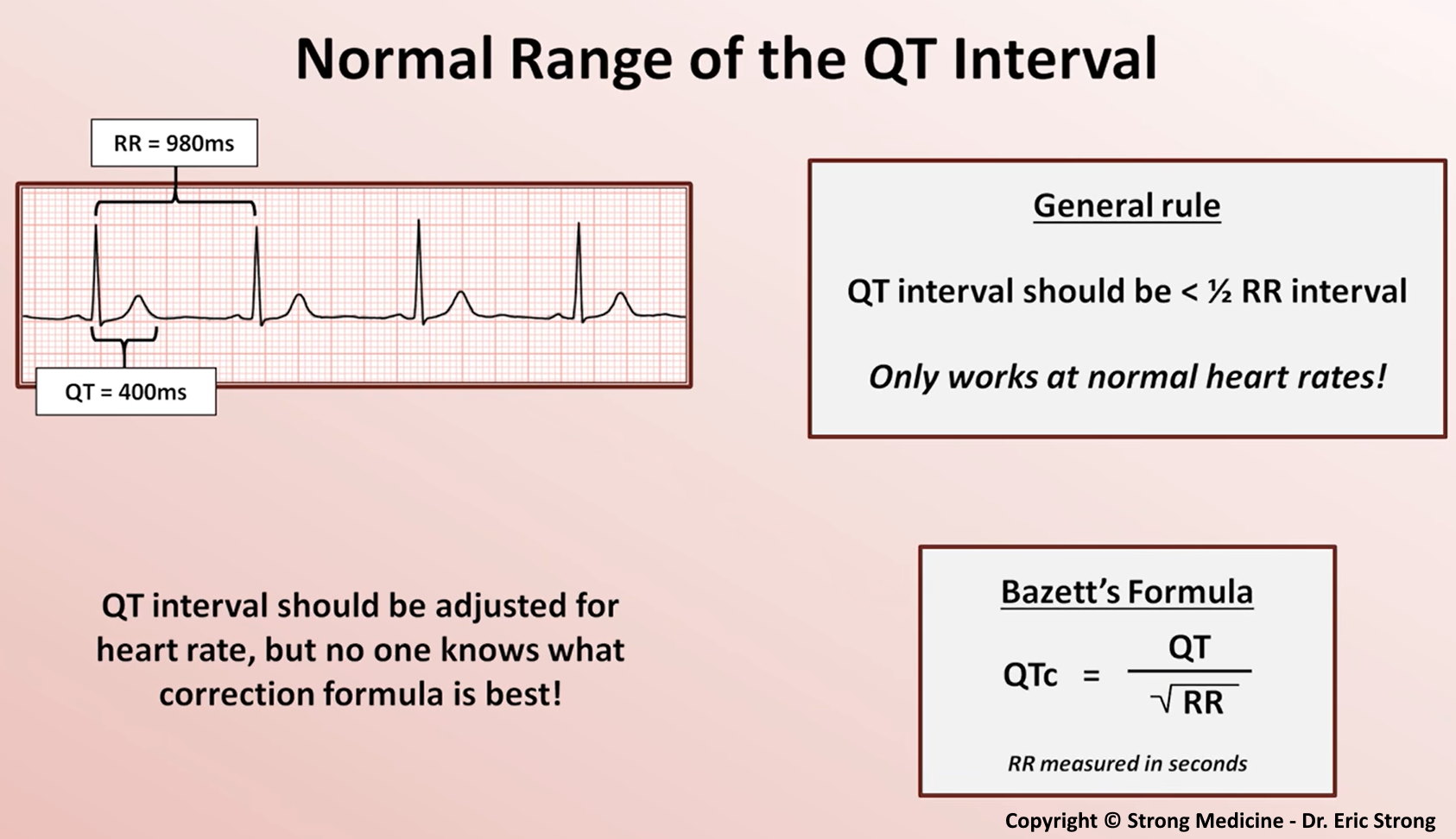

Finally, within-person variability and measurement error are additional sources of variability in the QT interval length.īazett’s correction is still recommended for the diagnosis of congenital long and short QT syndrome ( 8, 9). Other factors associated with QT interval length variability include age, sex, hypertension, body mass index, medication usage, low-calorie diets, serum potassium levels, and common genetic variants ( 7). Marked prolongations in the QT interval may be caused by genetic disorders (e.g., long QT syndrome), pharmacological agents (e.g., antiarrhythmics, antipsychotics, and antibiotics), electrolyte abnormalities (e.g., hypokalemia and hypomagnese-mia), and their interactions ( 7). Normal values for the QTc range from 350 to 450 ms for adult men and from 360 to 460 ms for adult women however, 10%-20% of otherwise healthy persons may have QTc values outside this range. The electrocardiographic QTc is approximately normally distributed in the general population. Bazett’s formula is the most commonly used method to calculate QTc and adjusts for the heart rate, although it tends to underestimate the duration of repolarization when the heart rate is particularly slow (or overestimate when the heart rate is fast). Prophylactic beta-blocker therapy has been recommended for high-risk patients, and decisions may be individualized for low-risk patients.Frequently, reference ranges for the QT-interval in the general population are expressed in terms of QTc, a corrected form of the QT interval ( 3- 6). All patients with mutations at the LQT3 locus have relatively high risk of cardiac events. Men with LQT2 mutations and QTc of less than 500 msec have relatively low risk of cardiac events, whereas all women with LQT2 mutations have relatively high risk. QTc of more than 500 msec is a risk marker for LQT1 for either gender. LQT2 and LQT3 mutations were associated with event rates approaching 50 percent. The QTc is QT corrected for heart rate, and cardiac event was defined as syncope, cardiac arrest, or sudden death. In one large study, 15 mutations of LQT1 were the least hazardous, with a 30 percent probability of cardiac events by age 40 years. Risk stratification for these patients is based on the locus, length of the QTc interval with a cutoff of 500 msec, and gender. The most common mutations related to the long QT syndrome are in three genetic loci termed LQT1 and LQT2 (potassium channel genes) and LQT3 (a sodium channel gene).

Identifying the specific gene mutation in a given patient with long QT syndrome can help guide prophylactic therapy. Beta blockers, potassium supplements, and implantable defibrillators have been used for treatment of long QT syndrome. Unfortunately, not all persons with long QT syndrome have premonitory symptoms or identifiable electrocardiographic abnormalities, and they may first present with sudden death. Long QT syndrome should be suspected in patients with recurrent syncope during exertion and those with family histories of sudden, unexpected death. Torsades de pointes and ventricular fibrillation are the usual fatal arrhythmias. Most cardiac events are precipitated by vigorous exercise or emotional stress, but they also can occur during sleep. In addition to a prolonged QT interval, which occurs in some but not all persons with long QT syndrome, another characteristic electrocardiographic abnormality is the so-called Brugada sign (an upward deflection of the terminal portion of the QRS complex). The median age of persons who die of long QT syndrome is 32 years men are predominately affected. Some of the highest rates of inherited long QT syndrome occur in Southeast Asian and Pacific Rim countries. Recently, attention has focused on a group of inherited gene mutations in cardiac ion channels that cause long QT syndrome and carry an increased risk for sudden death. A number of drugs are known to cause QT prolongation (e.g., terfenadine), as are hypokalemia, hypomagnesemia, myocarditis, and endocrine and nutritional disorders. A prolonged QT interval is a common thread among the various entities associated with sudden arrhythmia death syndrome. Some cases are caused by sudden arrhythmia death syndrome. In approximately 5 percent of sudden cardiac deaths, no demonstrable anatomic abnormality is found.


 0 kommentar(er)
0 kommentar(er)
